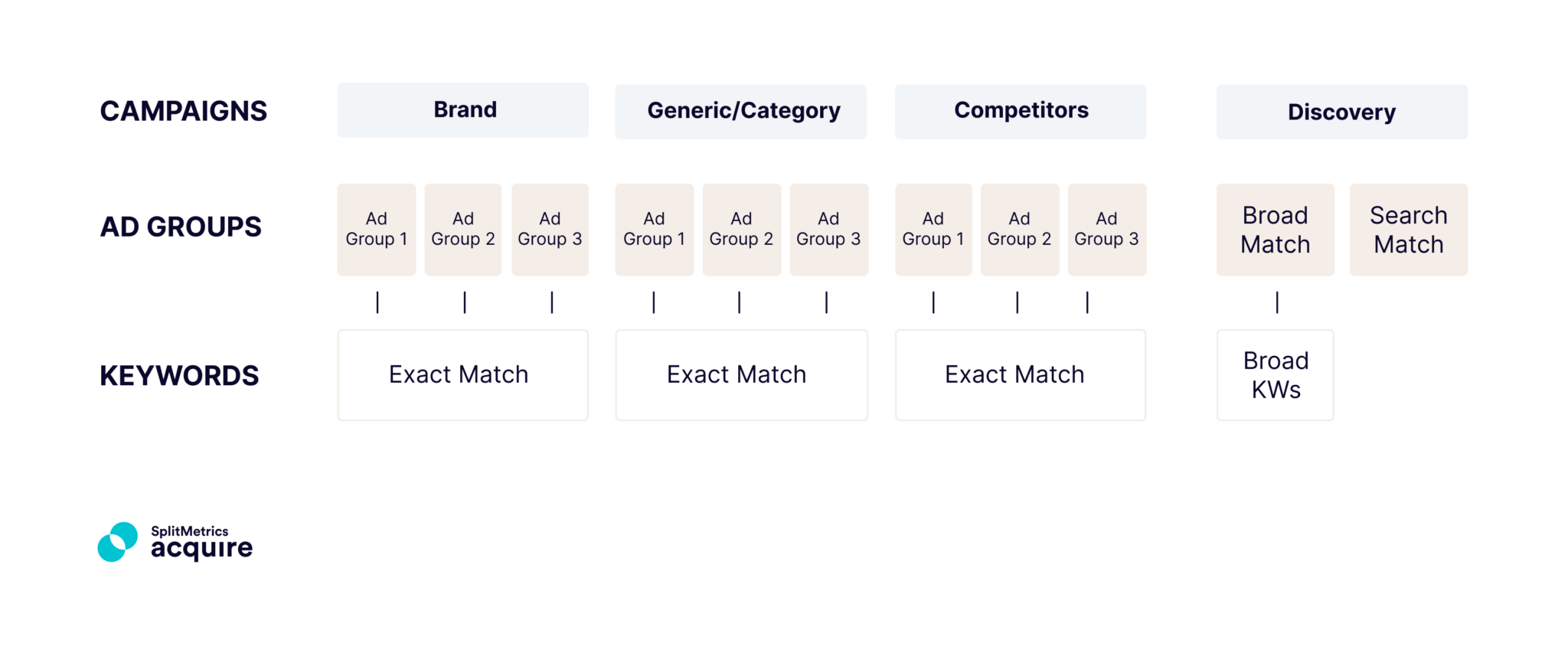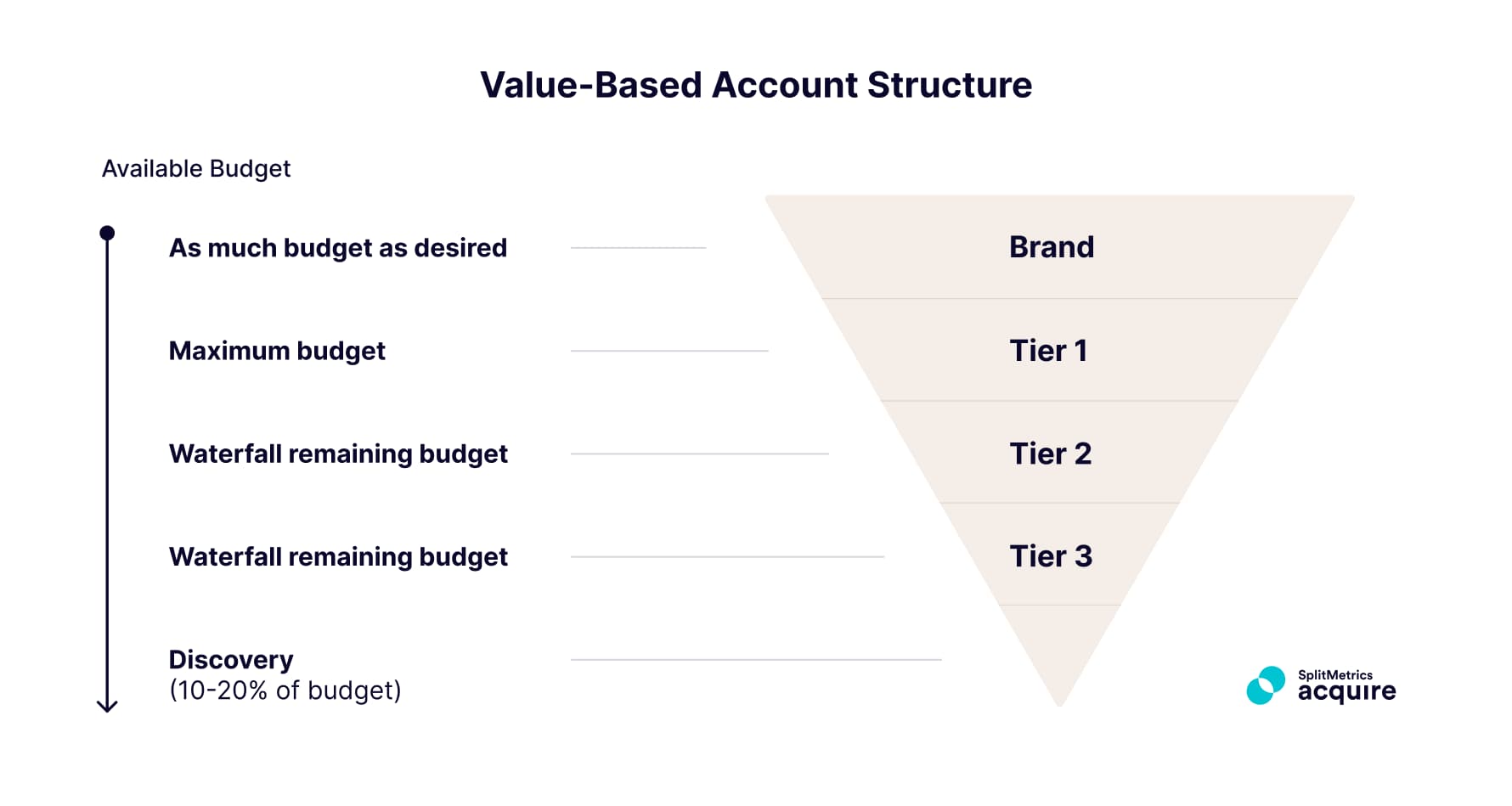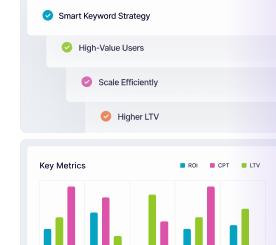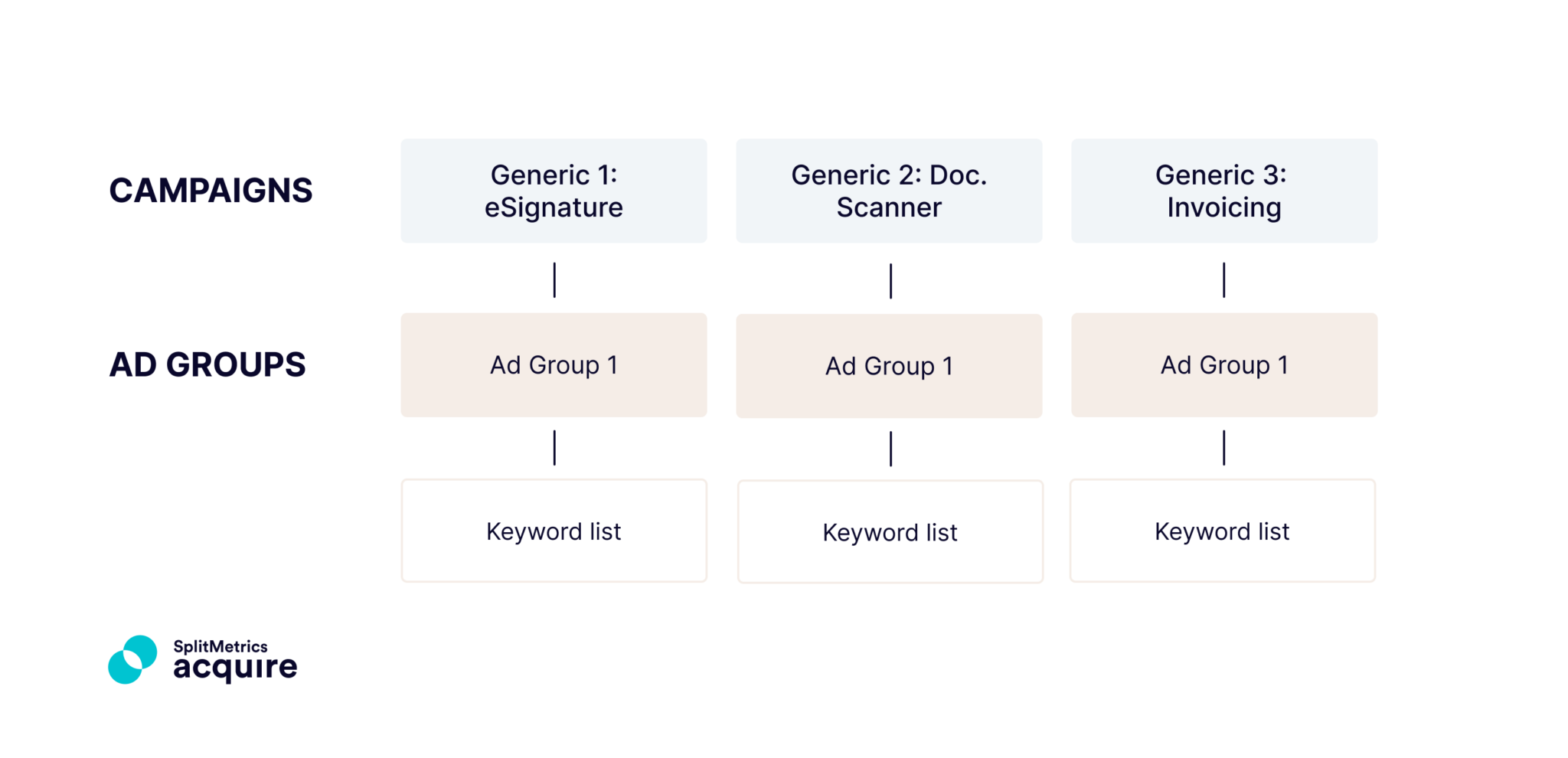How to Choose the Right Apple Ads Campaign Structure for Search Results Ads?
 Gabriel Kuriata
Gabriel Kuriata  Gabriel Kuriata
Gabriel Kuriata An account structure for search results ads in Apple Ads defines how campaigns, ad groups, keywords, and ads are organized. It provides the tools necessary for data analysis and optimization, making bulk operations effortless and configuring automation in SplitMetrics Acquire intuitive.
Planning an account structure is the first step towards advertising on the App Store, as we highlighted in our beginner’s to expert guide to Apple Ads.
How do you choose and create the proper Apple Ads campaign structure for search results ads? There are best practices, but a high degree of flexibility is possible.
Revenue goals dictate any app’s Apple Ads strategy, which implies which structure will serve them best. Apple Ads optimization and management always occur within the framework set by the structure. This interrelation influences transparency, ease of analysis, workflow, and workload.
Building a profitable and scalable Apple Ads campaign structure is a high-priority task for anyone wanting to advertise on the App Store. It involves choosing and adjusting the right approach to one’s needs and capabilities.
Read this article to:
– Understand Apple Ads strategy elements influencing campaign types;
– Compare the two most popular approaches to campaign and budget management;
– Get to know universal best practices, applicable regardless of structure
– Learn how to adjust each structure to one’s business needs and budget.
Apple Ads recommends a structure organizing keywords by theme. We refer to this as a semantics-based account structure. This is the most common method, but another approach is also possible, which organizes keywords by their value, expressed in their ability to drive downloads by users with high lifetime value (LTV) or users who generate desired revenue within a specific timeframe. This approach is referred to as a value-based campaign structure.
The Apple Ads semantic campaign structure is the most commonly chosen. Still, our clients use both approaches or implement concepts behind the value-based Apple Ads campaign structure in the semantics-based one.
Other Apple Ads placements are assigned their campaigns and always function next to the search results ads campaign structure, regardless of approach.
Let’s make one thing clear: if you’re a beginner or completely new to Apple Ads, it’s highly recommended that you choose the semantics-based account structure. The value-based one revolves around budget waterfalling and won’t be implementable without a proper mobile measurement partner (MMP) integration. Knowing how it works is good because its concepts might prove very useful when you grow your app and scale your campaigns… and you will do that with the free SplitMetrics Acquire Starter Plan:

A semantics-based campaign structure groups keywords by their theme. It should always include the following types of campaigns:

The semantics-based campaign structure is the best one for beginners, but it is great for advanced users, too:
There are a few things you should consider early on when implementing this approach to avoid unnecessary work in the future:
All in all, we highly recommend reading our comprehensive guide to building a semantics-based campaign structure. It discusses all the ways of expanding it, modifying it to suit various needs.

A value-based campaign structure in Apple Ads groups keywords by their profitability. Various metrics can serve as a grouping criterion. For example, return on ad spend (ROAS) can be measured at specific intervals to prioritize users with the highest lifetime value (LTV). We can optimize for in-app purchases, subscriptions, trials, or any type of goal with assigned monetary value.
In practice, the value-based campaign structure closely resembles the semantics-based one. It should always include brand and discovery campaigns:
The essence of this structure is grouping keywords into tiers:
It’s recommended to also include these types of Apple Ads campaigns in this structure:

Focus on keyword value makes it easier to optimize Apple Ads for profitability, leading to possible better ROAS and return on investment (ROI) overall. This is the crucial benefit behind some more experienced users evolving their structures in this direction. You can examine the process in our article on building a semantics-based account structure to see how increased granularity and planning can lead advertisers to incorporate elements of the value-based structure into their Apple Ads strategy.
There are multiple considerations, too. This is why this structure is chosen by more experienced users operating at bigger scales:
Should you wish to know more about the value-based structure, budget waterfalling, establishing criteria for keyword tiers, setting up goals, understanding LTV, and all the components vital to this structure, go to our article:

Both account structures can be optimized and customized to fit your goals perfectly. Both are flexible enough to incorporate elements of the other. All this can be done while adhering to best practices recommended by Apple Ads:
You can start with a basic semantics-based structure, gradually incorporating a more granular approach, grouping your category keywords into tiers, and waterfalling your budget assigned to them. The question is: does your Apple Ads strategy would benefit from such an approach?
Let’s analyze how Apple Ads optimization translates to all elements constituting a proper structure.

An Apple Ads strategy typically assumes several campaign goals within its scope and budget. Each goal requires a unique optimization approach that should influence the shape of any campaign structure.
First, let’s examine all the possible campaign types and their goals. Their unique goals are why you want all your blocks to be in place, according to Apple Ads best practices.
Brand campaigns have high user acquisition value. Branded keywords reflect high intent—they enjoy the best conversion rates and drive the best traffic, which will go to our competitors on the App Store without proper brand protection. Branded keywords should always be placed in a separate campaign, even in the case of a value-based campaign structure, to allow adequate optimization for these two goals, likely through maximization of impression share.

Category campaigns focus on user acquisition. Generic keywords can have varying values regarding cost per goal (CPG) or cost per acquisition (CPA). Semantic relevance doesn’t have to be perfectly aligned with value, though. This is why the tiered approach of the value-based campaign structure is frequently used for category campaigns alone. How it’s done is described in detail in our article on building a semantics-based account structure.
Competitor campaigns are also set up for user acquisition but are more tricky. Targeting our competitors’ branded keywords makes sense only when such keywords aren’t actively protected by bidding. Finding unprotected branded competitor keywords and using them for effective user acquisition is possible. Still, an action can always cause a reaction. Consequently, on average, competitor campaigns have lower conversion rates and value than brand and category ones.
Theoretically, a value-based campaign structure can eliminate competitor campaigns, allocating keywords to the proper tiers depending on their value (typically tier 2 or tier 3).
However, we recommend separating competitor campaigns for two reasons. The first is better transparency. The second is that you may want to target a specific impression share for these keywords, and realizing this goal will be easier with a separate campaign.
This means that regardless of your approach to Apple Ads campaigns, you’ll always follow the best practices officially recommended by the advertising platform.
Discovery campaigns are a unique entity in Apple Ads. An Apple Ads discovery campaign aims to find new relevant keywords for other campaigns. Discovery campaigns also work well to cover traffic for low search volume (LSV) keywords. Adding too specific keywords to separate exact match groups and optimizing them for a few installs is usually pointless. Instead, you can allow Search Match to do all the work for you and match your ads to specific search queries.

An insufficiently developed semantic core (generic keyword pool) is a significant consideration for all advertisers seeking success with Apple Ads, and discovery campaigns are a crucial solution next to manual keyword research. We strongly recommend them, knowing that beginners should pay more attention to them. Apple Ads discovery campaigns are so vital that clients typically allocate as much as 20% of their advertising budget. Not paying attention to discovery campaigns is a common Apple Ads optimization mistake that sacrifices long-term app growth for short-term savings.
To summarize, the different goals of each campaign type and their unique considerations regarding competitiveness, relevance, and volatility of category and competitor campaigns are solid arguments for including them in your structure, regardless of approach.
Careful market, competitor, and keyword research shows that there’s always a way to grow. The analytical tools included in the free SplitMetrics Acquire Starter Plan can show new openings and help discover more opportunities to capitalize on.
International scaling may come into play sooner than you think. It’s possible to manage multiple markets in a single campaign. Still, we typically recommend a more granular approach because of the following reasons:
Targeting multiple markets in a single campaign allows for easy and relatively quick scaling, making the entire structure leaner, but it may need to be revised in the future. The difficulty of planning an international campaign Apple Ads structure, but rather budgeting and understanding each market’s prospects.
In Apple Ads, the daily budget is set on a campaign level. If particular objectives are critical to you, they should be organized into separate campaigns. This can include the already mentioned strategic markets, holiday promotions with unique seasonal category keywords (like summer workout, holiday photos, Christmas music, etc.), significant events, etc.
Both structures operate within the framework Apple Ads recommends and share many similarities. However, their differences impact the possible scope of optimization and management.
Keyword management involves continuously monitoring their performance and transferring them between campaigns depending on it. Both account structures should involve the following:
However, choosing a specific, value-based, or semantics-based approach and customizing it significantly impacts this process. A key factor determining keyword value is competition level in bidding. In consequence, keyword value changes frequently, mandating moving it between tiers in the value-based structure.
Choosing a more granular approach to category campaigns in the semantics-based account structure will significantly impact the work needed to maintain it, just like adding a proxy/probing campaign to the value-based structure.
The semantics-based campaign structure allows for an easy understanding of user intent. Still, a thematic grouping of keywords might not directly align with their value contribution, and popular ones might drive significant traffic but need more in-app engagement and revenue.
The value-based Apple Ads campaign structure performance assessment is directly linked to the value each keyword or group generates. Since ROI/ROAS groups keywords, it’s easier to gauge profitability and conversion rates within high, medium, or low-value categories, making it clear where optimizations will yield the highest ROI.
A semantics-based campaign’s structured budget is allocated across brand, competitor, category, and discovery campaigns. It’s flexible, allowing easy expansion with additional category campaigns for markets, events, or themes.
The value-based structure is tailored for strategic budget distribution, directing more resources to high-value keywords and conserving resources for low-priority segments. This allows for more controlled usage and minimizes overspending on less valuable terms.
However, planning and implementing waterfalling resources and expansion are considerably more challenging. We recommend starting with the basic semantics-based account structure and gradually making it more gradual, adopting budget waterfalling from the value-based approach.
Bidding in Apple Ads, which has a semantics-based structure, is often adjusted based on keyword performance within each campaign. This requires granular control of ad groups, keywords, and ads.
In a value-based structure, bid adjustments focus on maximizing ROI by optimizing high-value keywords first. This approach streamlines bid management and sets a clear direction and scope of activities. Bids on lower-value groups can be capped or reduced without losing substantial ROI, enabling tighter control over cost-per-goal (like purchases, subscriptions, etc.) targets.
Both structures allow easy, strategic implementation of custom product pages to maximize the profitability of strategic or high-potential keywords, allowing you to align visuals, messages, and tones to specific search intents.
A semantics-based structure makes it easy to strategize using ad variations, leading to custom product pages that can improve relevancy and engagement within each campaign type.
The same can be done in the value-based campaign structure. Creative optimizations will prioritize high-value segments, ensuring the most effective messaging for the highest ROI.
Evaluating the workload resulting from choosing one approach over the other is challenging, as an advertiser’s strategy and focus ultimately decide it. The free SplitMetrics Acquire Starter Plan makes this a non-issue with extensive automation and transparent Apple Ads management interface and features.
Theoretically, a semantics-based structure may require more detailed tracking, keyword analysis, and thematic optimizations across multiple themes. However, it’s very easy to plan and expand.
A value-based structure is generally more streamlined. This often reduces the need for daily adjustments in lower-value segments, making it easier to maintain while focusing resources on top-performing areas. However, the main challenge lies in budgeting, planning, and expansion.
Whether you choose the value-based approach or the semantics-based one, there are some Apple Ads best practices we recommend always sticking to:
A semantics-based campaign structure should suit all advertisers, beginners and experienced ones. It’s intuitive, focuses on user intent, and allows easy optimization towards high relevance and profitable Apple Ads performance.
A value-based campaign structure is best for teams prioritizing efficiency and high ROI/ROAS. This structure simplifies budget and bid management by focusing on high-value segments.
Both approaches have advantages depending on the level of control, workload, and optimization focus desired. A hybrid approach can sometimes be practical, where high-value keywords are managed with additional theme-based targeting within specific campaigns. Both can be easily automated with the free SplitMetrics Acquire Starter Plan.
